Louisiana State University Tiger Marching Band
The Louisiana State University Tiger Marching Band (also called the Golden Band from Tigerland or simply the Tiger Band) is the marching band of Louisiana State University (LSU). The 325-member band performs at all LSU football home games, all bowl games, and all away games.
| Louisiana State University Tiger Marching Band | |
|---|---|
 | |
| School | Louisiana State University |
| Location | Baton Rouge, Louisiana |
| Conference | SEC |
| Founded | 1893 |
| Director | Kelvin Jones |
| Associate Directors | Cliff Croomes, Simon Holoweiko |
| Members | 325 |
| Fight song | "Fight for LSU" |
| Website | www |
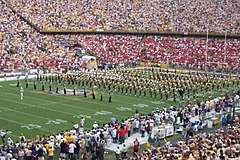
.jpg)
History
Cadet band
The LSU Tiger Band began as a military band in 1893, organized by two students: Wylie M. Barrow and Ruffin G. Pleasant.[1] Pleasant, who later became governor of the state of Louisiana, served as director of the eleven-piece cadet band.[2] (Pleasant was also quarterback of the football team and is credited along with football coach Charles E. Coates with changing LSU's official school colors from blue and white to purple and gold.)[3] The band averaged thirteen members in its early years.[2]
| Early Photographs of the Tiger Band LOUISiana Ditigal Library |
| Cadet Band pictured in front of Alumni Memorial Hall. Band performs at State Fair in Shreveport in 1916. |
In his written history of the band, former director of bands Frank Wickes describes the band's formative years:
By the turn of the century the Cadet Band also became a marching unit. Tours of the state and appearances at Mardi Gras festivities in New Orleans became early traditions. In 1904, the band joined four companies of cadets from LSU for a performance at the St. Louis World Exposition.[2]
The military duties of the band were numerous, and it was not until later when the band's role in athletic events became more prominent.[2] The band marched its first halftime show in 1924.[2][4]
Kingfish years
The band enjoyed some of its greatest growth when infamous Louisiana governor Huey P. Long took a heightened interest in increasing LSU's national prominence. For Long, the success of the band was inextricably linked to the success of the University.[5] In an oral history about the governor, Mary Hebert addresses Huey Long's preoccupation with the band:
| Photographs of Huey Long and the Tiger Band LOUISiana Ditigal Library |
| Long hands out dollar bills to members of the band. Long leads the band through streets. Long leading LSU band during game at Vanderbilt. |
...improving the university became one of his pet projects. It was not LSU's academic standing, however, that first attracted his attention--it was the band...The governor then demanded that the band be enlarged from twenty-eight to one hundred-twenty-five pieces...His band would be one of the largest in the country.[6]
He not only hand-picked the University's president, James Monroe Smith, but also hired a new band director, Castro Carazo, the orchestra leader at the Roosevelt Hotel in New Orleans.[1][6] Long initiated a massive increase in the band's membership and saw to it that the band's drab military dress was replaced with showier uniforms.[2][5] A number of songs were co-written for the band by Long and Carazo, including "Touchdown for LSU," "Darling of LSU," and "The LSU Cadets March."[2][5] "Touchdown for LSU" is still played today as part of the band's pregame performance. Long was often instrumental in lowering train ticket prices so that the band and students could travel to away football games.[1] Long would often lead the band through the streets during parades.[7]
Years after Long's assassination, many of the changes he made to the band and to the University were reversed as part of a backlash against his control over LSU and the associated scandals; for instance, Carazo was fired and the military uniforms were reinstated.[1]
After WWII
The band remained a military cadet band until the end of World War II when the band department became a part of the School of Music. "During the Carazo years, female students had appeared with the band as drum majorettes, but not in the ranks of musicians."[2] Women first joined the band in 1943.[1] A number of important changes were made to the band during this period, changes that shaped what the band is like today. The band hall burned to the ground in 1958 and a new hall was quickly built that is still used by the band.[1] The Ballet Corps (now known as the Golden Girls) was added by director Thomas Tyra in 1959, and the band's pregame performance that remains to this day was created in the 1960s by director William F. Swor.[2] Former director of bands Frank Wickes again describes the band at this time:
| Photographs of Tiger Band after WWII LOUISiana Ditigal Library |
| Halftime performance during LSU-Ole Miss game in 1968. Band creates a tiger on the field during halftime in 1968. |
The Tiger Band program hit its zenith in 1970 when LSU was named the All-American College TV Band in a one-time national contest sponsored by General Motors. After marching the Orange Bowl Parade on New Year's Eve and performing at halftime of the 1971 Orange Bowl game on New Year's Day, the Tiger Band flew to Oakland, Ca. On January 2, the band performed a different show for another national television audience and officially received the All-American College TV Band Award at halftime of the East-West Shrine Bowl. The trophy was presented to Director Swor by Meredith (The Music Man) Willson, confirming LSU's prominence among the country's top university marching bands.[2]
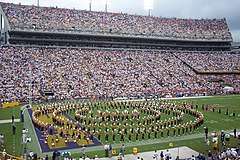
Continued quest for excellence
In the fall of 1997, the band directors of the Southeastern Conference unanimously voted the LSU Tiger Marching Band the best marching band in the SEC according to a survey taken by the Northwest Arkansas Times.[2] The band was awarded the Sudler Trophy in 2002, a one-time award conferred upon the nation's best college marching bands.[8]
Three women have led Tiger Band as drum majors: Kristie Smith (1999) season, Mindy Hebert (2000), and Mary Bahlinger (2014).
The band continues to be a celebrated part of the University community; some members report being asked for autographs.[9] The current look of the band has been memorialized in a set of 17 miniature, hand-painted figurines that includes the different members of the band and that sells for almost $400.[10][11] One group of fans has even chosen to memorialize the band's Pregame performance by creating shirts with the first four notes of the band's fanfare.[12] On Saturday, October 11, 2008, ESPN announced that the Tiger Band won first place in a competition amongst university bands from Auburn, Clemson, Florida, Georgia, Texas, and USC. Each band played a version of John Williams's Indiana Jones theme, and ESPN posted the videos online for fans to vote.[13] At halftime during the 2009 home football game against Vanderbilt, the band was inducted into the Louisiana Music Hall of Fame. In 2010, the LSU Golden Girls performed in Hong Kong as part of the Chinese New Year celebration marking the first ever international performance by the Golden Band from Tigerland. In 2012, the LSU Tiger Band was named as one of the "Top Ten College Marching Bands in the United States" by the Huffington Post. The Tiger Band added another international performance In 2014 when all 325 members traveled to Dublin, Ireland to perform in the St. Patrick's Day Parade.
Traditions
Victory Hill
On game days, the band marches from the band hall to Tiger Stadium, stopping along the way at Victory Hill, located right outside the stadium. "Thousands of fans lining North Stadium Drive listen for the cadence of drums announcing the band's departure from the Greek Theatre" and await the impending arrival of the band.[14] The band stops on the hill and begins to play the opening strains of the "Pregame Salute." Then, while playing the introduction to "Touchdown for LSU," the band begins to run in tempo through the streets and down the hill amidst the crowd of cheering fans. The band also marches from the stadium to the band hall upon the conclusion of the game, a practice not usually employed by other bands.[9]
| Photograph of Tiger Band Performing Pregame LOUISiana Ditigal Library |
| Band in signature "LSU" formation in 1968. |
| Video of Tiger Band Performing Pregame YouTube |
| Band performing in Tiger Stadium |
Pregame
One of the most celebrated traditions carried on by the band is its pregame performance at each home football game. The performance includes pieces from the band's expansive repertoire of school songs, including "Pregame Salute"/"Touchdown for LSU" arranged in 1964 by director William F. Swor specifically for the band to play during pregame.[15] The drill design and musical selections pieced together by Swor remain relatively unchanged today. The band also uses a more traditional style of marching (called the "peak step" by directors and members of the band) during pregame, a style that requires the band members to lift their legs to mid-calf as they march.
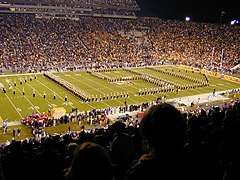
The band begins the performance in the south end zone of the stadium and is called to attention by the drum major right before he marches out across the end zone in front of the band. Stopping at the goal line, the drum major wields his mace and uses his whistle to signal the band to take the field. The band marches out of the end zone to the beat of a single bass drum in fronts separated by five-yard intervals. The drum major halts at the 40 yard line on the far end of the field and the band is now spread across the southern half of the field with the color guard at midfield and the southern goal line. The golden girls line up next on the west sideline next to the band. The band stands at attention and awaits the percussion introduction to "Pregame Salute." As the band plays the stirring opening chords of the salute (which are taken from the tune "Tiger Rag"), the band turns to face all four corners of the stadium. The crowd explodes in cheers. Once the band salutes each part of the stadium, the pace of the music and the marching picks up, the music transitions into Long's "Touchdown for LSU," and the band sweeps the field. Toward the end of the song, the band breaks the fronts and spells out "LSU."
In the "LSU" formation, the band plays the "LSU Alma Mater" and the "Star-Spangled Banner" and is directed at the north 47 and a half yard line by the director of bands. The band then plays "Fight for LSU" as it virtually flips the formation to spell LSU for the fans on the east side of the stadium. Upon arriving in the new formation, the band plays the second half of "Tiger Rag," which culminates in the crowd chanting "T-I-G-E-R-S, TIGERS!' in unison. This is followed the "First Down Cheer," to which the east side of the stadium in unison responds to each of the three refrains with "GEAUX! TIGERS!" and to the final refrain with "LSU!" To the sound of a fast-paced drum cadence, the band returns to the original "LSU" formation facing the west side of the stadium and replays the "First Down Cheer" as the crowd responds. The band immediately breaks into an encore performance of "Touchdown for LSU" as it reforms the original fronts, marches to the north end zone, and then breaks the fronts to form a tunnel through which the football team will enter the field.
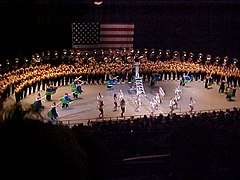
Tigerama
Each fall, the marching band and the University's top concert performance ensembles join forces for a concert featuring musical highlights from the football season. It is one of the most patriotic concerts that you will ever see. This annual concert, called Tigerama, is now in its 31st year.[16] Tigerama begins with the LSU Wind Ensemble and the LSU Symphonic Winds playing a number of pieces including "LSU Rhapsody," a concert medley of school songs, and "God of Our Fathers," which includes an antiphonal brass finale during which members of the Tiger Band brass join both of the concert ensembles. During the second half of the concert, the Tiger Band enters to its traditional cadence, plays songs from each show from the current football season, and concludes with traditional school songs. Tigerama was once performed in the LSU Student Union Theatre, then was moved to the Pete Maravich Assembly Center, then to the Baton Rouge River Center, and is now back in the Pete Maravich Assembly Center. On a few occasions, Tigerama was a traveling showcase for the Band Department at various performance venues throughout the state.
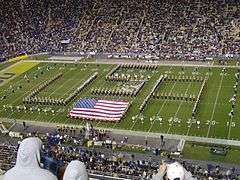
LSU Salutes
Each fall, the band honors its own humble beginnings as a cadet band and the history of the University during LSU Salutes by performing a halftime show with a patriotic theme. Usually during alternating years the band plays a medley of songs representing each branch of the U.S. Armed Forces, spells out the names of each branch, and recognizes the members of each branch present in the stadium. This is also the only time when the Golden Girls and Colorguard change their look and don special red, white, and blue uniforms for the performance. LSU Salutes, generally celebrated during Veterans Day weekend, is a set of events that recognizes cadets who served in the U.S. Armed Forces. Until 1969, every entering male student at LSU was required to participate in the ROTC program for at least two years.[17] LSU was once referred to by students and staff alike as the Ole War Skule, and LSU ROTC programs provided more than 12,000 soldiers for World War II—a number eclipsed only by Texas A&M University(14,123 officers), and the military academies.[17][18] The military heritage of the University dates back to its very establishment in 1860 as a military training institution; future American Civil War general William Tecumseh Sherman served as its first superintendent.[19]
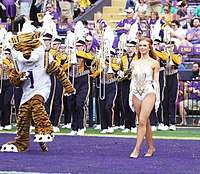
Golden Girls and Colorguard
As the band evolved into a full-blown show band, featured auxiliary units were created to add entertainment.
The LSU Golden Girls, a feature unit with the Tiger Band and the oldest and most established danceline on the LSU campus, was created in 1959 as the Ballet Corps by then director of bands Thomas Tyra.[20] The Golden Girl moniker became official in 1965. Today, the line includes eighteen dancers who audition each year to make the line and who are often members of private dance studios.[15]
The LSU Colorguard, a flag spinning unit not to be confused with a traditional military colorguard, was established in 1971.[21] The audition process includes a solo, self-choreographed routine, fundamentals and an on-the-spot routine performed for a panel of judges. Twenty-six to thirty-two female or male spinners are selected from this process.[21] For a brief period in the 1980s the Colorguard was co-ed, but hadn't had a male performer until again in 2018. The LSU Colorguard hosts two male performers currently.[15]
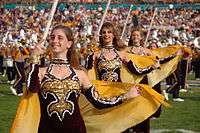
Uniforms
In August 2017 Tiger Band purchased new uniforms that continued the more recent tradition of purple pants and gold coats with Greek key trim, a motif that can be found on the outside of Thomas Boyd Hall and David Boyd Hall on LSU's campus.[22]
Songs of LSU
"LSU Alma Mater"
The "LSU Alma Mater" was written in 1929 by Lloyd Funchess and Harris Downey, two students who developed the original song and music because LSU's first alma mater was sung to the tune of "Far Above Cayuga's Waters" and was used by Cornell University.[23] The band plays the "Alma Mater" during pregame and at the end of each home football game. Also, members of the band join arm-in-arm at the end of rehearsals on Saturday game days and sing the "Alma Mater" before leaving the practice facility.
"Fight for LSU"
"Fight for LSU" is the University's official fight song and was written by Castro Carazo in the 1940s. The band plays "Fight for LSU" often, most notably when the team enters the field (while the band is in a tunnel formation at the end of its pregame performance), successfully kicks a field goal, scores an extra point, or completes a two-point conversion. Following a halftime performance, the band often exits the field while playing "Fight for LSU." The full song uses elements of a musical march and consists of an introduction, a strain that is played twice (and sung twice using the same lyrics), a breakup strain (with new lyrics), a return to the introduction, a final repetition of the original strain (at a faster tempo and with the original lyrics), and a coda.
"Pregame Salute"/"Touchdown for LSU"
"Pregame Salute"/"Touchdown for LSU" is often incorrectly considered by fans to be the school's official fight song. The opening chords and melodies of the "Pregame Salute" were derived from "Tiger Rag," a popular jazz tune from 1917, while "Touchdown for LSU," which directly follows the "Pregame Salute" both on the field and in the stands, was written in part by Huey P. Long. This song is played most notably during pregame, during the march down Victory Hill, and at the beginning of the fourth quarter of each football game.
"Hey, Fightin’ Tigers"
"Hey, Fightin’ Tigers" was adopted as a school song in the 1960s by then director of bands Thomas Tyra. Originally titled "Hey, Look Me Over" and written by Cy Coleman for the musical Wildcat, starring Lucille Ball, a version of the song with its new lyrics by Carolyn Leigh, who wrote the original lyrics of "Hey Look Me Over", after the athletic department purchased the rights to use the song.[19] The band plays this song often in the stands and on occasion will play it to conclude a halftime performance while spelling out "LSU" or "Tigers." The song itself consists of an introduction, a repeated verse (with lyrics), a drum break during which the band and crowd both shout "T-I-G-E-R-S," and a jazz version of the original tune with various opportunities for the crowd to shout out "LSU." Typically, the full ensemble plays the verse once and then sings the second time while the percussion, tubas, and piccolos play.
The Bengal Brass Basketball Band which plays at all basketball games also plays "Hey Fightin' Tigers" with different lyrics.
"Tiger Rag"
"Tiger Rag" was first made popular by the Original Dixieland Jazz Band in 1917. It has been adopted by a number of schools who, like LSU, claim a tiger as a mascot. LSU started using the song in 1926, making them the first school to use the melody. It was brought to the university by the serving band director Joseph Hemingway. It has been said that years later, Clemson's band director was in Baton Rouge one 1942 Saturday night, and brought it back to South Carolina as his prized possession. The "Hold that Tiger" portion of the song (which musically consists of one pitch played three times followed by a second pitch, up a major third, played once) is the most recognizable portion of the song for LSU fans, as it is incorporated (at different tempos) into both the "Pregame Salute" and the "First Down Cheer." Upon the scoring of a touchdown, the band plays the "Hold that Tiger" portion of the song, which concludes with a "T-I-G-E-R-S" cheer from the crowd.
Other pieces
- First, second, and third down cheers are played when the Tigers are on offense. The "First Down Cheer" includes the "Hold that Tiger" musical phrase from "Tiger Rag." The "Second Down Cheer" is a musical selection that is followed by the crowd chanting L-S-U! The "Third Down Cheer" is based on the song "Eye of the Tiger" made famous by Survivor.
- "Tiger Bandits" was created to pay homage to the defensive unit from the 1958 national championship football team. Coach Paul Dietzel called the unit the "Chinese Bandits."[24] The title of the song was eventually changed to "Tiger Bandits" (or just simply "Bandits") to make the tradition more inclusive. The band plays the song when the Tiger defense forces the opposing team to punt on fourth down or makes a noteworthy defensive play (such as intercepting a pass).
- "Darling of LSU" and "The LSU Cadets March" were both composed by Huey P. Long and band director Castro Carazo. The songs are no longer a part of the band's everyday repertoire.[2]
- "LSU Tiger Triumph March" was written by Karl King in honor of the band and was first played in Tiger Stadium when the Tigers took on Tennessee in 1952.[2][25]
- The Dem Franchize Boyz song "Talkin' Out da Side of Ya Neck!" has occasionally been played by the band. As it is associated with a vulgar crowd cheer, the song was banned from the band from 2010 to 2013, and has since been played sparingly.[26][27][28]
Bengal Brass
A group of 72 members selected from the ranks of the band constitute the Bengal Brass Basketball Band, often simply referred to as Bengal Brass.[29] This group consists mostly of brass players with a few woodwind players. (and percussionists on a trap set) is often split into two squads—purple and gold—and performs at LSU select home volleyball matches, many home gymnastics meets, all home men's basketball, and all home women's basketball games in the Pete Maravich Assembly Center. Bengal Brass also travels with the men's and women's basketball teams during postseason play, including trips by both teams to the Final Four. The band has performed in a number of cities in the United States including Boston, Jacksonville, Indianapolis, San Antonio, Nashville, Cleveland, Austin, New Orleans, Atlanta, San Francisco, Tampa, Pittsburgh, and Seattle among others.
Facilities
Band Hall
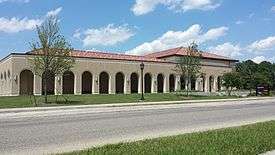
The LSU Tiger Band Hall is a 17,740-square-foot Italian Renaissance style complex located on Aster Street by the LSU north gates.[30] The 8.7 million complex dedicated on April 26, 2012, was designed by the architecture firm Howard Performance Architecture with Percy J. Matherne Contractor Inc. serving as the project's general contractor.
The complex is used for rehearsals by the Tiger Band and the LSU School of Music's entire band area, including the Wind Ensemble, Symphonic Winds and Symphonic Band concert groups.[30] The facility also hosts concerts and recitals and stores the band's musical instruments, field equipment and band uniforms along with Colorguard banners and Golden Girl uniform accessories. The complex includes a lobby that showcases a band trophy case along with the band's first indoor rehearsal hall/practice space which is based on the floor space of the Pete Maravich Assembly Center. The Bert and Sue Turner Tiger Band Rehearsal Hall includes a projection screen and mirrored walls to accommodate Colorguard and Golden Girl rehearsals. The hall also includes double sets of motorized curtains that line the walls to help with acoustics.[30] (Tiger Band Hall dedication ceremony)
Funding for the project was made possible through an action of the Louisiana Legislature along with matching funds from the university. LSU's matching funds were provided from athletics ticket sales and private donors raised approximately $2 million toward construction of the facility.
LSU has had two other band halls. LSU's second band hall was constructed in 1959 and still stands today. It was built to hold 140 players and is attached to the Music & Dramatic Arts Building, next to the LSU Greek Theater.[31] The original band hall was constructed in 1936 and was destroyed by fire in 1958.[32]
Outdoor Practice Field
The band has outdoor practice fields used for rehearsals during the week. The outdoor fields also include a 133-square-foot base conductor's tower which oversees the practice fields.
Indoor Practice Facility
During pre-season camp and on all Saturday home game days, the band uses the LSU Indoor Practice Facility that is part of the Football Operations Center. The indoor facility was built in 1991, is a climate-controlled 82,500 square feet, and is adjacent to LSU's four outdoor 100-yard football practice fields used by the LSU football team.
Notable alumni
- Bill Conti received an Academy Award for his score to The Right Stuff and is also a longtime musical director and conductor for the Academy Awards. Some of his other credits include scores for the James Bond film For Your Eyes Only, Rocky (including the "Gonna Fly Now" theme), and The Karate Kid. He also composed themes for ABC Primetime and Dynasty.[33]
- Emmy Award winner Julie Giroux is credited with writing music for over 100 movie and television programs.[34]
- H. Owen Reed is a composer, conductor, and author, whose works for band demonstrate his devotion to the study of the traditional musical styles of Mexican, Native American, Anglo-American, and African American cultures. He has also published eight books on the subjects of musical composition and music theory.
- Clifton Williams wrote a number of prolific pieces for band and won the inaugural American Bandmasters Association's Ostwald Award for Original Band Literature in 1956 for his first band composition, "Fanfare and Allegro."
- Carl Fontana, trombonist
References
- Ruffin, Thomas F. (2002). Under Stately Oaks: A Pictorial History of LSU. Louisiana State University Press. ISBN 0-807126-82-9.
- Wickes, Frank (2007). "The Marching Tigers: A Brief Look at Over 100 Years of the LSU Tiger Band, 'The Golden Band from Tigerland'". Louisiana State University Department of Bands. Accessed on 1 June 2007. Archived from the original on 17 August 2007. Retrieved 10 August 2007.
- Little, Nancy (2002). "Tiger Rag: Rekindling a Rivalry and Returning a Tradition". Louisiana State University Media Relations. Accessed on 4 June 2007. Archived from the original on 26 September 2011. Retrieved 10 August 2007.
- Frost, Emma (2004). "A day in the life of the Tiger Band: Writer follows the Band for a day". The Daily Reveille. Accessed on 1 June 2007. Archived from the original on 20 December 2007. Retrieved 10 August 2007.
- "Huey Long's Programs – Louisiana State University". Long Legacy Project (2006). Accessed on 1 June 2007.
- Hebert, Mary (1994). "'I've Got a University': Huey Long and LSU's Golden Years". T. Harry Williams Center for Oral History. Louisiana State University. Accessed on 4 June 2007. Archived from the original on 2 September 2006. Retrieved 10 August 2007.
- Everson, Darren (2008) (5 December 2008). "'What the Rise of Southern Football Says About America". The Wall Street Journal. Accessed on 6 December 2008.
- Leger, Benjamin (2002). "Golden Band from Tigerland awarded trophy". The Daily Reveille. Accessed on 1 June 2007.
- Bachman, Rachel (2004). "Postcard from Louisiana: Upending Stereotypes, Fans of LSU Geek for the Band". The Oregonian. Accessed on 4 June 2007.
- "Louisiana State University Products". The Little Band Man Company. Accessed on 4 June 2007. Archived from the original on 28 September 2007. Retrieved 10 August 2007.
- Mitchell, Dennis (2004). "Golden Band recreated in collectible form: Company founded by former student". The Daily Reveille. Accessed on 4 June 2007.
- "92,000 fans. 4 notes. 1 experience". Gametime Shirts. Accessed on 23 October 2007.
- "ESPN Battle of the Bands". ESPN. Accessed on 11 October 2008. Archived from the original on 11 October 2008. Retrieved 11 October 2008.
- "Tiger Band". LesMiles.net. Louisiana State University Athletic Department. Accessed on 3 June 2007. Archived from the original on 16 October 2007. Retrieved 10 August 2007.
- Burris, Alexandria (2003). "Music to cheer by: Golden Band boasts long legacy". The Daily Reveille. Accessed on 1 June 2007. Archived from the original on 24 July 2008.
- Leger, Benjamin (2002). "Annual 'Tigerama' event entertains crowd: Wind ensemble, band display talents". The Daily Reveille. Accessed on 1 June 2007. Archived from the original on 20 December 2007. Retrieved 10 August 2007.
- Grantham, Natalie (2004). "Saluting Military History: University's history remembered". The Daily Reveille. Accessed on 1 June 2007. Archived from the original on 2011-07-14.
- "LSU Salutes - History". Louisiana State University. Accessed on 1 June 2007.
- "Quickfacts". Louisiana State University. Accessed on 1 June 2007. Archived from the original on 9 June 2007. Retrieved 10 August 2007.
- "LSU Golden Girls". Louisiana State University Department of Bands. Accessed on 3 June 2007. Archived from the original on 30 July 2012.
- "LSU Colorguard". Louisiana State University Department of Bands. Accessed on 3 June 2007.
- Blum, Christine, Ruby, Mackenzie, Vinnie, & Zachary (2018). "The Show Band of the South: The Evolution of the LSU Tiger Band Fashion from the 1950s to Today". What They Wore: A Fashion History at LSU. Accessed on 5 June 2019.
- Markway, Rebecca (2003). "Campus 411: Stuff you never knew about LSU". The Daily Reveille. Accessed on 4 June 2007. Archived from the original on 4 October 2007.
- "National Champions - 1958". LesMiles.net. Louisiana State University Athletic Department. Accessed on 3 June 2007. Archived from the original on 17 October 2007. Retrieved 10 August 2007.
- "Karl King Tunes - L-M". www.karlking.us. Fort Dodge Public Library. Accessed on 3 June 2007.
- "LSU fans under fire once again for singing obscene lyrics at games". Houston Chronicle. 2013-12-17. Retrieved 2018-10-08.
- "LSU marching band rewards fans with 'Neck' after game, but that 5-word phrase returns too..." The Advocate. Retrieved 2018-10-08.
- Gallo, Andrea. "LSU officials struggle to rein in rambunctious student section". The Advocate. Retrieved 2018-10-08.
- "LSU Bengal Brass". Louisiana State University Department of Bands. Accessed on 3 June 2007. Archived from the original on 26 July 2011.
- "LSU College of Music & Dramatic Arts Unveils New Tiger Band Hall". lsu.edu. Retrieved 2015-05-02.
- "LSU Tiger Marching Band to move into new facility next month". theadvocate.com/. Retrieved 2015-05-02.
- "LSU Band History, The Marching Tigers, A Brief Look at Over 100 Years of the LSU Tiger Band". lsu.edu. Archived from the original on 2015-05-12. Retrieved 2015-05-02.
- "Bill Conti". Internet Movie Database Inc. Accessed on 1 June 2007.
- "Julie Giroux". Internet Movie Database Inc. Accessed on 1 June 2007.